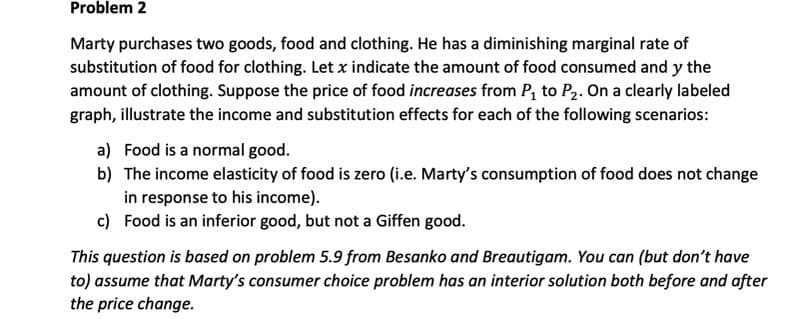Marty purchases two goods, food and clothing. He has a diminishing marginal rate of substitution of food for clothing. Let x indicate the amount of food consumed and y the amount of clothing. Suppose the price of food increases from P, to P2. On a clearly labeled graph, illustrate the income and substitution effects for each of the following scenarios: a) Food is a normal good. b) The income elasticity of food is zero (i.e. Marty's consumption of food does not change in response to his income). c) Food is an inferior good, but not a Giffen good. This question is based on problem 5.9 from Besanko and Breautigam. You can (but don't have to) assume that Marty's consumer choice problem has an interior solution both before and after the price change.
Marty purchases two goods, food and clothing. He has a diminishing marginal rate of substitution of food for clothing. Let x indicate the amount of food consumed and y the amount of clothing. Suppose the price of food increases from P, to P2. On a clearly labeled graph, illustrate the income and substitution effects for each of the following scenarios: a) Food is a normal good. b) The income elasticity of food is zero (i.e. Marty's consumption of food does not change in response to his income). c) Food is an inferior good, but not a Giffen good. This question is based on problem 5.9 from Besanko and Breautigam. You can (but don't have to) assume that Marty's consumer choice problem has an interior solution both before and after the price change.
Principles of Microeconomics (MindTap Course List)
8th Edition
ISBN:9781305971493
Author:N. Gregory Mankiw
Publisher:N. Gregory Mankiw
Chapter21: The Theory Of Consumer Choice
Section: Chapter Questions
Problem 5CQQ
Related questions
Question

Transcribed Image Text:Problem 2
Marty purchases two goods, food and clothing. He has a diminishing marginal rate of
substitution of food for clothing. Let x indicate the amount of food consumed and y the
amount of clothing. Suppose the price of food increases from P, to P2. On a clearly labeled
graph, illustrate the income and substitution effects for each of the following scenarios:
a) Food is a normal good.
b) The income elasticity of food is zero (i.e. Marty's consumption of food does not change
in response to his income).
c) Food is an inferior good, but not a Giffen good.
This question is based on problem 5.9 from Besanko and Breautigam. You can (but don't have
to) assume that Marty's consumer choice problem has an interior solution both before and after
the price change.
Expert Solution
This question has been solved!
Explore an expertly crafted, step-by-step solution for a thorough understanding of key concepts.
This is a popular solution!
Trending now
This is a popular solution!
Step by step
Solved in 4 steps with 3 images

Recommended textbooks for you

Principles of Microeconomics (MindTap Course List)
Economics
ISBN:
9781305971493
Author:
N. Gregory Mankiw
Publisher:
Cengage Learning

Principles of Economics (MindTap Course List)
Economics
ISBN:
9781305585126
Author:
N. Gregory Mankiw
Publisher:
Cengage Learning


Principles of Microeconomics (MindTap Course List)
Economics
ISBN:
9781305971493
Author:
N. Gregory Mankiw
Publisher:
Cengage Learning

Principles of Economics (MindTap Course List)
Economics
ISBN:
9781305585126
Author:
N. Gregory Mankiw
Publisher:
Cengage Learning


Economics: Private and Public Choice (MindTap Cou…
Economics
ISBN:
9781305506725
Author:
James D. Gwartney, Richard L. Stroup, Russell S. Sobel, David A. Macpherson
Publisher:
Cengage Learning

Microeconomics: Private and Public Choice (MindTa…
Economics
ISBN:
9781305506893
Author:
James D. Gwartney, Richard L. Stroup, Russell S. Sobel, David A. Macpherson
Publisher:
Cengage Learning
